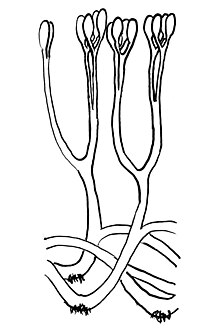Polysporangiophyte
| Polysporangiophyte Temporal range: Latest Ordovician - Recent |
|
|---|---|
 |
|
| Reconstruction of Aglaophyton, illustrating bifurcating axes with terminal sporangia, and rhizoids. | |
| Scientific classification | |
| Kingdom: | Plantae |
| Clade: | Embryophytes |
| Clade: |
Polysporangiophytes Kenrick & Crane (1997) |
| Clades | |
|
|
Polysporangiophytes, also called polysporangiates or formally Polysporangiophyta, are plants in which the spore-bearing generation (sporophyte) has branching stems (axes) that terminate in sporangia. The name literally means many sporangia plant. The clade includes all land plants (embryophytes) except for the bryophytes (liverworts, mosses and hornworts) whose sporophytes are always unbranched. While the definition is independent of the presence of vascular tissue, all living polysporangiophytes also have vascular tissue, i.e., are vascular plants or tracheophytes. Fossil polysporangiophytes are known that have no vascular tissue, and so are not tracheophytes.
Paleobotanists distinguish between micro- and megafossils. Microfossils are primarily spores, either single or in groups. Megafossils are preserved parts of plants large enough to show structure, such as stem cross-sections or branching patterns.
Dawson, a Canadian geologist and paleobotanist, was the first to discover and describe a megafossil of a polysporangiophyte. In 1859 he published a reconstruction of a Devonian plant, collected as a fossil from the Gaspé region of Canada, which he named Psilophyton princeps. The reconstruction shows horizontal and upright stem-like structures; no leaves or roots are present. The upright stems or axes branch dichotomously and have pairs of spore-forming organs (sporangia) attached to them. Cross-sections of the upright axes showed that vascular tissue was present. He later described other specimens. Dawson's discoveries initially had little scientific impact; Taylor et al. speculate that this may have been because his reconstruction looked very unusual and the fossil was older than was expected.
From 1917 onwards, Robert Kidston and William H. Lang published a series of papers describing fossil plants from the Rhynie chert – a fine-grained sedimentary rock found near the village of Rhynie, Aberdeenshire, Scotland, now dated to the Pragian of the Lower Devonian (around 411 to 408 million years ago). The fossils were better-preserved than Dawson's, and showed clearly that these early land plants did indeed consist of generally naked vertical stems arising from similar horizontal structures. The vertical stems were dichotomously branched with some branches ending in sporangia.
...
Wikipedia
